High-Mass (Greater than 8 M⊙) Stars and Type II Supernovae
Due to their increased gravitationally driven compression, stars with more than 8 M⊙ heat their cores enough to cause the carbon and oxygen there to fuse. As a result, their evolution and fate are very different from those of low-mass stars.
413
13-5 A series of fusion reactions in high-mass stars leads to luminous supergiants
When helium fusion ends in the core of a star more massive than 8 M⊙, the inward pressure created by the gravitational force from its outer layers compresses the carbon-oxygen core, driving the star’s central temperature above 600 million K. Now, carbon fusion begins, producing such elements as neon and magnesium. When a star compresses itself enough to elevate its central temperature to 1.2 billion K, neon fusion occurs, creating oxygen and magnesium. When the central temperature of the star then reaches 1.5 billion K, oxygen fusion begins, producing sulfur, silicon, and phosphorus. The process of converting lower-mass elements into higher-mass ones is called nucleosynthesis.
As the core temperature increases, the core’s fusion rate soars. Also, each succeeding core stage has fewer and fewer nuclei than the previous one. For example, because each helium atom is made up of four hydrogen atoms, only one-quarter as many helium atoms exist in a star’s core as there were hydrogen atoms. Combining the higher fusion rate and fewer fusible atoms causes each cycle of core thermonuclear fusion to occur more rapidly than the previous stage. For example, detailed calculations for a star that was initially 25 M⊙ on the main sequence reveal that carbon fusion occurs for 600 years, neon fusion for 1 year, and oxygen fusion for only 6 months. After half a year of core oxygen fusion, gravitational compression forces the central temperature up to 2.7 billion K, and silicon fusion begins. This thermonuclear process proceeds so furiously that the entire core supply of silicon in a 25 M⊙ star is converted into iron in 1 day.
Each stage of fusion adds a new shell of matter outside of the core (Figure 13-10), creating a structure that resembles the layers of an enormous onion. Together, the tremendous numbers of fusion-generated photons created in all of these shells, as well as in the core, push the outer layers of the star farther and farther outward. The star expands to become a luminous supergiant, almost as wide across as Jupiter’s orbit around the Sun.
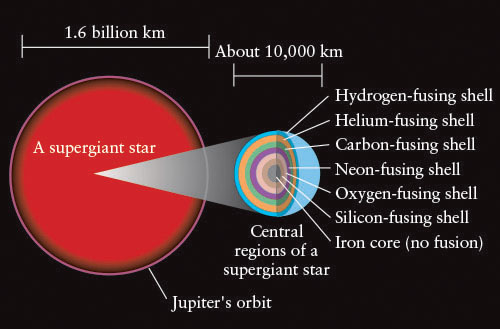
High-mass main-sequence stars evolve into luminous supergiant stars that are brighter than 105 L⊙, emit winds throughout most of their existence, and have mass-loss rates that exceed those of giants (see Section 12-9). Figure 13-11 shows a supergiant star losing mass. Betelgeuse (see Figure 11-2a), 470 ly away in the constellation of Orion, is another good example of a supergiant experiencing mass loss. Spectroscopic observations show that Betelgeuse is losing mass at the rate of 1.7 × 10−7 M⊙ per year and is surrounded by ejected gas, in a circumstellar shell. This huge shell is expanding at 10 km/s, and escaping gases have been detected at distances of 10,000 AU from the star. The expanding circumstellar shell has an overall diameter of one-third of a light-year.
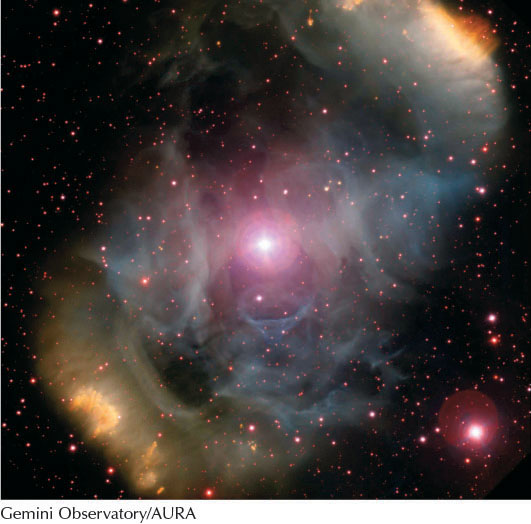
Silicon fusion in high-mass stars involves many types of nuclear reactions, but its major final product is iron. Eventually, the core is converted entirely into iron, which is surrounded by layers of shell fusion that consume the remaining reserves of fuel deep inside the star (see Figure 13-10). While the star’s enormously bloated atmosphere is nearly as big as the orbit of Jupiter, its entire energy-producing region is contained in a volume the size of Earth. The buildup of an inert core of iron nuclei and electrons signals the impending violent death of a massive star.
414
13-6 High-mass stars blow apart in Type II supernova explosions
Margin Question 13-4
Question
Where in massive stars are the higher-mass elements formed?
Unlike lighter elements, iron cannot fuel further thermonuclear reactions. The protons and neutrons inside iron nuclei are already so tightly bound together that no further energy can be extracted by fusing still more particles with them. The sequence of fusion stages in the cores of high-mass stars therefore ends.
Because iron atoms do not fuse and emit energy, the electrons in the core must now support the star’s outer layers by the strength of electron degeneracy pressure alone. Soon, however, the continued deposition of fresh iron from the silicon-fusing shell causes the core’s mass to exceed the Chandrasekhar limit. Electron degeneracy suddenly fails to support the star’s enormous weight, and the core collapses.
Any isolated main-sequence star of more than 8 M⊙ develops an iron core as a luminous supergiant. When the core collapses, a rapid series of cataclysms is triggered that tears the star apart in a few seconds. Let us see how this happens in the death of a 25 M⊙ star, according to computer simulations (Table 13-1).
| Stage | Central temperature (K) | Central density (kg/m3) | Duration of stage |
|---|---|---|---|
| Hydrogen fusion | 4 × 107 | 5 × 103 | 7 × 106 years |
| Helium fusion | 2 × 108 | 7 × 105 | 5 × 105 years |
| Carbon fusion | 6 × 108 | 2 × 108 | 600 years |
| Neon fusion | 1.2 × 109 | 4 × 109 | 1 year |
| Oxygen fusion | 1.5 × 109 | 1 × 1010 | 6 months |
| Silicon fusion | 2.7 × 109 | 3 × 1010 | 1 day |
| Core collapse | 5.4 × 109 | 3 × 1012 | 0.2 second |
| Core bounce | 2.3 × 1010 | 4 × 1017 | milliseconds |
| Supernova explosion | about 109 | varies | hours |
In a 25 M⊙ star, electron degeneracy pressure fails when the density is sufficiently high inside the iron core. The core, only some 3000 km in diameter, then collapses immediately. In roughly  second, the central temperature exceeds 5 billion K. Gamma-ray photons associated with this intense heat have so much energy that they begin to break apart the iron nuclei, a process called photodisintegration. Although millions of years passed from the time the star arrived on the main sequence with a hydrogen- and helium-filled core until its core became iron, it takes less than a second to convert the core back into elemental protons, neutrons, and electrons!
second, the central temperature exceeds 5 billion K. Gamma-ray photons associated with this intense heat have so much energy that they begin to break apart the iron nuclei, a process called photodisintegration. Although millions of years passed from the time the star arrived on the main sequence with a hydrogen- and helium-filled core until its core became iron, it takes less than a second to convert the core back into elemental protons, neutrons, and electrons!
Within another  second, as the density continues to climb, the electrons in the core are forced to combine with the core’s protons to produce neutrons, and the process releases a flood of neutrinos. As we saw in Section 10-9, neutrinos have no electric charge and have very little mass, and most pass through Earth or the Sun without interaction. Nevertheless, the matter deep inside a collapsing high-mass star is so fantastically dense that its newly created neutrinos cannot immediately escape from the star’s core. Slamming into nearby particles, the neutrinos provide a pressure pushing outward from the core.
second, as the density continues to climb, the electrons in the core are forced to combine with the core’s protons to produce neutrons, and the process releases a flood of neutrinos. As we saw in Section 10-9, neutrinos have no electric charge and have very little mass, and most pass through Earth or the Sun without interaction. Nevertheless, the matter deep inside a collapsing high-mass star is so fantastically dense that its newly created neutrinos cannot immediately escape from the star’s core. Slamming into nearby particles, the neutrinos provide a pressure pushing outward from the core.
 According to the calculations, about
According to the calculations, about  second after the collapse begins, the density of the entire core reaches 4 × 1017 kg/m3, which is nuclear density, the density at which neutrons and protons are normally packed together inside individual atomic nuclei. (Compare this with the density of water, 103 kg/m3.) When the neutron-rich material of the core reaches nuclear density, it suddenly stiffens. Thus, the core resists the collapse much more than when it was less dense. The collapse of the core halts so abruptly that it rebounds and begins rushing back out in a process called core bounce.
second after the collapse begins, the density of the entire core reaches 4 × 1017 kg/m3, which is nuclear density, the density at which neutrons and protons are normally packed together inside individual atomic nuclei. (Compare this with the density of water, 103 kg/m3.) When the neutron-rich material of the core reaches nuclear density, it suddenly stiffens. Thus, the core resists the collapse much more than when it was less dense. The collapse of the core halts so abruptly that it rebounds and begins rushing back out in a process called core bounce.
The model predicts that, during this critical stage, the star’s unsupported layers of shell-fusing matter outside the core are plunging inward at up to 15% of the speed of light. The outward-flowing neutrinos and rebounding core slam into this matter (the red regions in Figure 13-12a). The impact stops the core’s rebound while causing the infalling matter to reverse course. In just a fraction of a second, a tremendous volume of matter begins to move back up toward the star’s surface. This matter accelerates rapidly as it encounters less and less resistance, and soon it forms an outgoing shock wave, analogous to the thunder created by a lightning flash. After a few hours, this shock wave reaches the star’s surface, lifting the star’s outer layers away from the core in a colossal blast. The star becomes a Type II supernova.
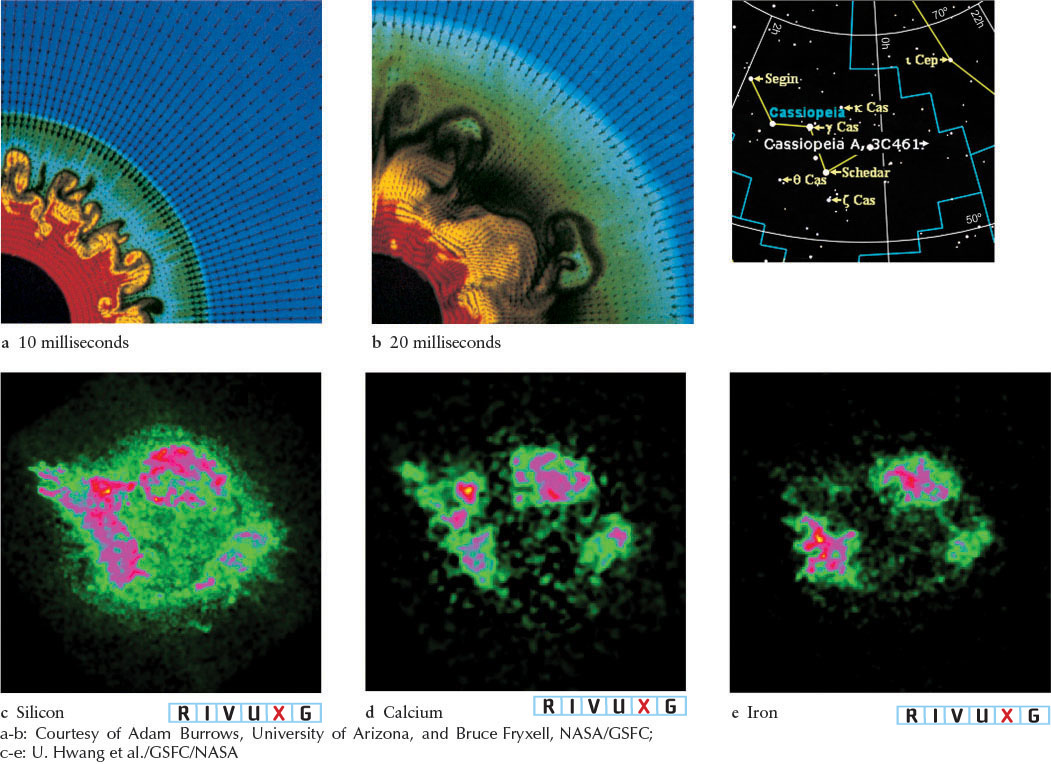
415
As the supernova expands, the star’s luminosity, which was already some 104 L⊙ to 105 L⊙, suddenly increases by another factor of between 103 and 106. A supernova is often 10% as bright as all of the other stars in its galaxy combined. The brightest supernova that has been observed emitted as much energy as a hundred billion stars as luminous as our Sun!
Margin Question 13-5
Question
What role do neutrinos play in Type II supernovae?
 Many of the elements with more protons than iron are created during supernovas. Recall from Chapter 4 that neutrons can transform into protons by emitting an electron. As the layers of a massive dying star are blasted into space, they are compressed so much by the neutrinos and the shock wave that neutrons are forced into the elements that have been created as the star evolved. Packed with extra neutrons, many of these nuclei are unstable. As a result, neutrons begin emitting electrons, a process that converts these neutrons to protons. Once this occurs, that nucleus is no longer the element it was a moment before. For example, a neutron-enriched iron atom transforms into cobalt when a neutron transforms to a proton in it. Whereas the neutron-enriched iron was not stable, the cobalt it becomes can be—an atom of cobalt has been created. This process creates many of the heavy elements that exist today. Likewise, the supernova can cause atoms to bond together and create interstellar dust particles (see Sections 5-1 and 5-2). In summary, the products of shell fusion and this final burst of fusion during supernovae are where many of the heavy elements on Earth and other terrestrial planets come from, including some of the atoms in our bodies. We really are made of stardust.
Many of the elements with more protons than iron are created during supernovas. Recall from Chapter 4 that neutrons can transform into protons by emitting an electron. As the layers of a massive dying star are blasted into space, they are compressed so much by the neutrinos and the shock wave that neutrons are forced into the elements that have been created as the star evolved. Packed with extra neutrons, many of these nuclei are unstable. As a result, neutrons begin emitting electrons, a process that converts these neutrons to protons. Once this occurs, that nucleus is no longer the element it was a moment before. For example, a neutron-enriched iron atom transforms into cobalt when a neutron transforms to a proton in it. Whereas the neutron-enriched iron was not stable, the cobalt it becomes can be—an atom of cobalt has been created. This process creates many of the heavy elements that exist today. Likewise, the supernova can cause atoms to bond together and create interstellar dust particles (see Sections 5-1 and 5-2). In summary, the products of shell fusion and this final burst of fusion during supernovae are where many of the heavy elements on Earth and other terrestrial planets come from, including some of the atoms in our bodies. We really are made of stardust.
Computer simulations indicate that the onion skins of different elements do not just move out of a star going supernova in lockstep (Figure 13-12a, b). Therefore, the ejected gases are not expected to be uniform shells of matter. Indeed, observations reveal that the material emerging in a supernova comes out quite irregularly. Figure 13-12c–e show the distributions of some of the elements in the supernova Cassiopeia A (Cas A). Other observations show that some of the dense elements, like iron, ejected in supernovae are actually created deep inside the innermost silicon and oxygen layers of the supernovae and then shot out like bullets or geysers. Other elements are created throughout the expanding stars. However, calculations and observations reveal that supernovae do not create enough of the heaviest elements, like gold, silver, and platinum, to account for the amounts of these elements found on Earth. We will explore their likely origin in Section 13-14.
416
The Process of Science
The best scientific theories and models also provide explanations about matters that they were not initially designed to study. In modeling stellar evolution and supernovae, the processes that create and eject metals (that is, elements heavier than hydrogen and helium) from stars also provide the elements necessary for life to exist.
Margin Question 13-6
Question
Why does most of the iron on Earth not come from the iron cores of high-mass stars that explode as Type II supernovae?
Over its lifetime, our model 25-M⊙ star ejects more than 20 M⊙ of its mass back into space—by stellar winds, by gas ejected during unstable periods, and during its supernova phase. Less massive stars return proportionately less mass to the interstellar medium.
The spectrum and light curve of a Type II supernova are both significantly different from those of a Type Ia supernova. Whereas hydrogen lines are absent from a Type Ia’s spectrum, they are strong in the spectra of Type II supernovae. Both types begin with a sudden rise in brightness (see Figure 13-9). However, a Type II supernova usually peaks at M = −17, a hundred times dimmer than a Type Ia. Whereas Type Ia supernovae decline gradually for more than a year, Type II supernovae alternate between periods of steep and gradual declines in brightness. Type II light curves, therefore, have a step-like appearance.
13-7 Supernova remnants are observed in many places
Astronomers have seen more than 1000 supernovae. These observations suggest that in a typical galaxy like the Milky Way, Type Ia supernovae occur approximately once every 36 years, whereas Type II supernovae occur about once every 44 years. Thus, there should be about 5 supernovae exploding in our Milky Way Galaxy each century. Vigorous stellar evolution in our Milky Way occurs primarily in the Galaxy’s disk, because stars there continue to form in its giant molecular clouds. The disk (which we are in and which we see edge-on as the milky white band of stars and glowing gas and dust across the sky) is also where supernovae explode.
Astronomers find the debris of local supernova explosions in the Milky Way scattered across the Galaxy’s disk. A beautiful example is the Cygnus Loop (see Figure 12-7). The star’s outer layers were blasted into space 20,000 years ago so violently that they are still traveling at supersonic speeds. As this expanding shell of gas plows through the interstellar medium, it collides with atoms and molecules, making the gases glow.
Many supernova remnants cover sizable fractions of the sky. The largest is the Gum Nebula, with an angular diameter of 60° (its central region is shown in Figure 13-13). This nebula looks so big because it is so close: Its near side is only about 300 ly from Earth. Studies of the Gum Nebula’s expansion rate suggest that the supernova exploded about 11,000 years ago. At maximum brilliance, the exploding star was probably as bright as the Moon at first quarter.
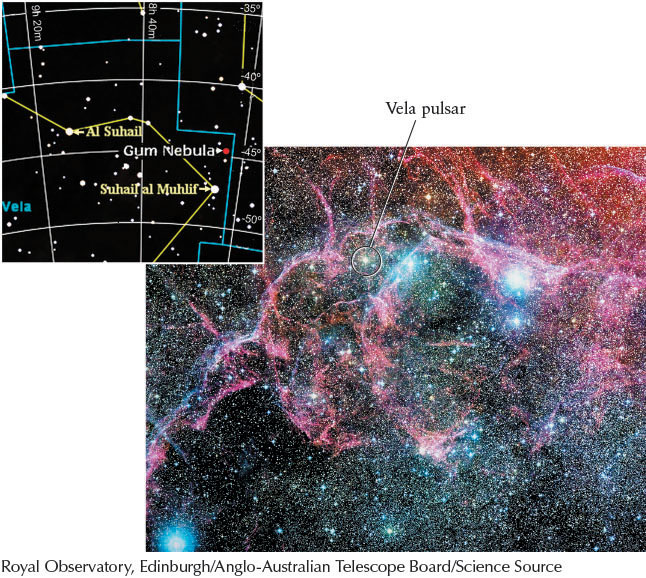
The Milky Way’s disk is so filled with interstellar gas and dust that we cannot see very far into it. Supernovae are thought to erupt every few decades in remote parts of our Galaxy, but their detonations are hidden from optical telescopes by the interstellar medium. Many supernova remnants in our Galaxy can be detected only at nonvisible wavelengths, ranging from X-rays through radio waves. For example, Figure 13-14 shows images of the supernova remnant Cassiopeia A as seen in radio (Figure 13-14a) and X-ray (Figure 13-14b). Visible-light photographs of this part of the sky reveal only a few small, faint wisps. Thus, radio searches for supernova remnants are more fruitful than visual searches. Only 24 supernova remnants have been found in visible-light photographs, but more than 3100 remnants in our Galaxy and in others have been discovered by radio astronomers.
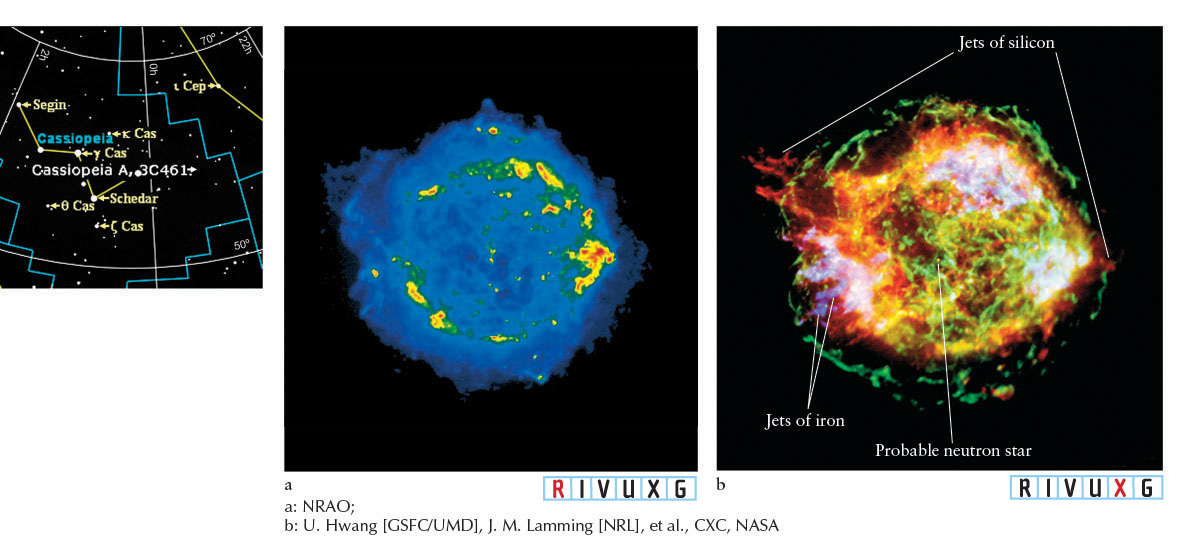
 Cassiopeia A Supernova remnants, such as Cassiopeia A, are typically strong sources of radio waves and X-rays. (a) A radio image produced by the Very Large Array (VLA). (b) A corresponding X-ray picture of Cassiopeia A taken by the Chandra Observatory. The opposing jets of silicon, probably guided by powerful magnetic fields, were ejected early in the supernova, before the iron-rich jets were released. Radiation from the supernova that produced this nebula first reached Earth 300 years ago. The explosion occurred about 10,000 ly from Earth.
Cassiopeia A Supernova remnants, such as Cassiopeia A, are typically strong sources of radio waves and X-rays. (a) A radio image produced by the Very Large Array (VLA). (b) A corresponding X-ray picture of Cassiopeia A taken by the Chandra Observatory. The opposing jets of silicon, probably guided by powerful magnetic fields, were ejected early in the supernova, before the iron-rich jets were released. Radiation from the supernova that produced this nebula first reached Earth 300 years ago. The explosion occurred about 10,000 ly from Earth.
417
From the expansion rate of the nebulosity in Cassiopeia A, astronomers calculate that the light from that supernova explosion first reached Earth about 300 years ago. Although telescopes were in wide use by the late 1600s, no record of the event is known. In fact, the last supernova of a star near its maximum brightness in our Galaxy, seen by the naked eye, was observed by Johannes Kepler in 1604. In 1572, Tycho Brahe also recorded the sudden appearance of an exceptionally bright star in the sky. While it has been centuries since the last supernova visible to the naked eye occurred in our Galaxy, supernovae are so bright that some naked-eye events in other galaxies have been seen. Perhaps the most notable one is SN 1987a, which we explore in the next section.
Margin Question 13-7
Question
Why are we unable to see all the supernovae in our Galaxy?
In 2002, astronomers discovered that 2 million years ago a group of bright O and B stars, called the Scorpius-Centaurus OB association, passed within 130 ly of Earth, and that one or more supernovae in this group may have occurred at that time. Such a close explosion could have damaged Earth’s ozone layer and caused the extinction of some ocean life shortly after the beginning of the Pleistocene epoch on Earth.
Besides the gas and dust enriched with heavy elements, supernovae leave a heritage long after their remnants have dissipated. Much of this gas and dust is recycled into new stars and planets, such as our solar system.
13-8 Supernova 1987A offered a detailed look at a massive star’s death
Some supernovae in other galaxies can be seen without a telescope. In 1885, a supernova in the Andromeda Galaxy was just barely visible to the unaided eye. On February 23, 1987, a supernova was observed in the Large Magellanic Cloud, a galaxy near our own Milky Way. The supernova, designated SN 1987A, was the first to be observed that year (Figure 13-15), and it was so bright that it could easily be seen with the naked eye. What made SN 1987A such an exciting discovery was that it gave astronomers a rare opportunity to study the death of a nearby massive star using modern equipment that provided data with which to verify the theory of supernovae described earlier.
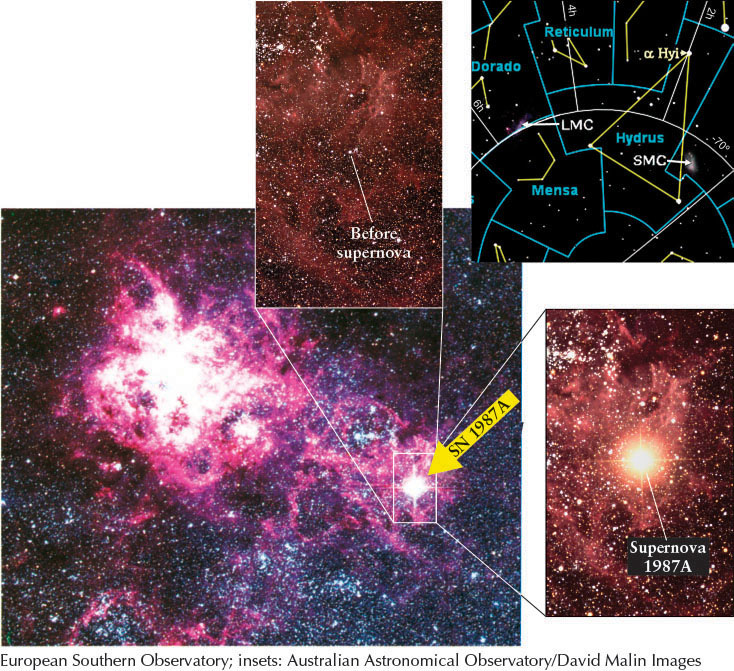
418
At first, SN 1987A reached only a tenth of the luminosity predicted for an exploding massive star. For the next 85 days, it gradually brightened. Then it began dimming, as is characteristic of an ordinary supernova. Fortunately, the star had been observed before it became a supernova (Figure 13-15 insets). The Large Magellanic Cloud is about 160,000 ly from Earth—near enough to us that many of its stars have been individually observed and catalogued. The star had been identified as a B3 supergiant. The theory of the evolution of such stars provided an explanation for SN 1987A’s unusually slow brightening.
When this star was on the main sequence, its mass was about 20 M⊙, although by the time it exploded, it had shed many solar masses. The evolutionary track for an aging 20 M⊙ star wanders back and forth across the top of the H-R diagram, so the star alternates between being a hot (blue) supergiant and a cool (red) supergiant. The star’s size changes significantly as its surface temperature changes. A blue supergiant is only 10 times larger in diameter than the Sun, but a red supergiant of the same luminosity is 1000 times larger. Because the doomed star was a relatively small blue supergiant when it exploded, it reached only a tenth of the brightness that it would have attained had it been a red supergiant at that time.
Ordinary telescopic observations of a supernova explosion can only show us the expanding outer layers of the dying star. No photons created in the core can penetrate through the supernova gases directly to our telescopes. As the outer layers of the supernova thin, however, neutrinos escape directly from the core into space. By detecting these neutrinos and measuring their properties, astronomers can learn many details about the star’s collapsing core, especially about core bounce. Several neutrino detectors were operating when the neutrinos from SN 1987A reached Earth.
Nearly a day before SN 1987A was first observed in the sky, teams of scientists at neutrino detectors in Japan and the United States reported observing Cerenkov flashes (see Section 10-9) from a burst of neutrinos. The Kamiokande II detector in Japan detected 12 neutrinos at about the same time that 8 were found by the IMB (Irvine-Michigan-Brookhaven) detector in a salt mine under Lake Erie. Neutrinos preceded the visible supernova outburst because they escaped from the dying star before the shock wave from the collapsing core reached the star’s surface. The particles were detected in Earth’s northern hemisphere, where the supernova is always below the horizon, after having passed through Earth. The discovery of these neutrinos provided strong support for the theory that supernovae are caused by the collapse of a star’s core, its subsequent bounce, and the flow of neutrinos that help cause the supernova, as described in Section 13-6.
| 1 |
|---|
| 2 |
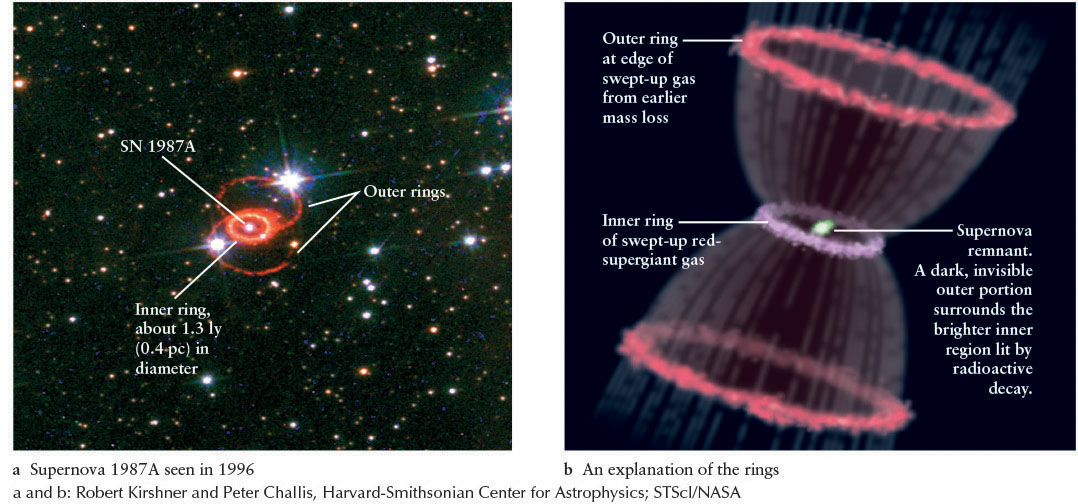
419
While emitting these gases, the doomed star was a red supergiant. It then shrank and in its final blue giant phase, the same star emitted higher-speed gas that compressed the hourglass gas into three rings—a narrow one around the equator and wider ones at the top and bottom of the hourglass. This relic gas is now being illuminated by photons from the supernova. In 1998, astronomers began to observe gas ejected from the supernova striking the preexisting inner ring of gas. This collision has caused that ring to brighten, and it also illuminates more and more of the gas that had been ejected earlier.
SN 1987A provided astronomers with invaluable information, in part because the doomed star had been studied before it exploded and its distance from Earth was known. The supernova was also located in an unobscured part of the sky, and neutrino detectors happened to be operating at the time of the outburst. Astronomers will be monitoring the progress of this supernova for years to come.
13-9 Cosmic rays are not rays at all
 In observations connected with supernovae, astronomers have detected particles flying through space at speeds that exceed 90% of the speed of light. These high-speed particles are called cosmic rays or primary cosmic rays. They were named rays before their true identity as particles was known, and, as often happens, this misleading name has stuck. About 90% of cosmic rays are protons (hydrogen nuclei). A few percent of cosmic rays are electrons and positrons (positively charged electrons). Less than 1% of cosmic rays are nuclei of more massive, non-hydrogen elements.
In observations connected with supernovae, astronomers have detected particles flying through space at speeds that exceed 90% of the speed of light. These high-speed particles are called cosmic rays or primary cosmic rays. They were named rays before their true identity as particles was known, and, as often happens, this misleading name has stuck. About 90% of cosmic rays are protons (hydrogen nuclei). A few percent of cosmic rays are electrons and positrons (positively charged electrons). Less than 1% of cosmic rays are nuclei of more massive, non-hydrogen elements.
Most primary cosmic rays coming in our direction collide with gas in the atmosphere some 15 km above Earth’s surface. This is fortunate, because each cosmic ray packs an enormous amount of energy that potentially could harm living tissue. A collision in the air divides a cosmic ray’s energy among several gas particles, which are shoved Earthward. These particles, in turn, often hit other gas atoms, creating a cascade of lower-energy particles that eventually reach Earth’s surface as a cosmic ray shower (Figure 13-17). These cosmic rays created from atoms in our atmosphere are called secondary cosmic rays.
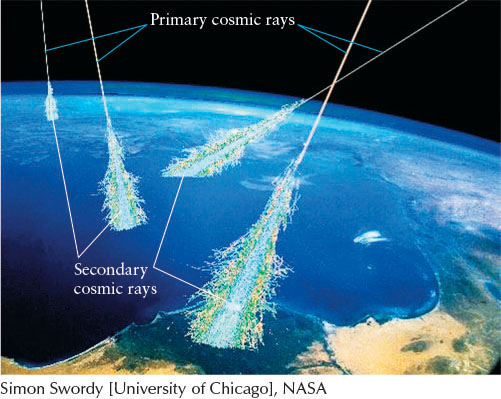
420
The origins of cosmic rays are beginning to become clear. At first, many astronomers thought that moderate-energy cosmic rays were emitted directly by supernovae. This theory made sense because these explosions are the best-known source of the energy necessary to give such cosmic rays their tremendous speeds. However, observations by the Advanced Composition Explorer satellite reveal that the isotopes of nickel coming to Earth in the form of cosmic rays are not the isotopes emitted by supernovae. Instead, evidence collected by the Fermi Gamma Ray Space Telescope in 2013 revealed that many cosmic rays are created when supernova debris slams into gas already in space, causing some of this preexisting matter to accelerate and become cosmic rays. Besides emitting particles, supernovae create gamma rays when cosmic ray protons created as a result of the supernova smash into normal protons in interstellar space. These collisions create short-lived particles called pions that decay into pairs of gamma rays.
Much less common than cosmic rays from supernova remnants are ultrahigh-energy cosmic rays, some of which come from inside our Galaxy, while many come from outside our Galaxy. Each of these particles has as much kinetic energy as a baseball thrown by a major league pitcher. In 2004, the Pierre Auger Observatory, consisting of 1600 cosmic ray sensors designed to detect the highest energy cosmic rays, was commissioned. Located on the Pampa Amarilla (“Yellow Prairie”) in Argentina, it is designed to give astronomers information about the directions from which these cosmic rays come. Observations of their paths suggest that many of them come from galaxies containing supermassive black holes, which we will discuss in Section 14-8. Whether these black holes themselves generate the ultrahigh-energy cosmic rays is still under investigation.